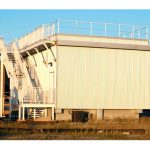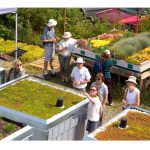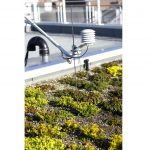
Additional Resources
For more information, please visit the BCIT Centre for Architectural Ecology (previously known as the BCIT Centre for Advancement of Green Roof Technology or CAGRT) at: www.greenroof.bcit.ca or contact info_greenroof@bcit.ca. Read Linda Velazquez’s Sky Gardens Blog post GPW: BCIT Green Roof Research Facility of August 13, 2011. See the Report to Canada Mortgage and Housing Corporation Technical Series 06-106 “West Coast Green Roof Performance at BCIT?s Green Roof Research Facility” of November 2006 PDF; visit the Canada Mortgage and Housing Corporation website at: http://www.cmhc-schl.gc.ca/. Contact Maureen Connelly, B.Sc., B.E.D.S., M.Arch., MAIBC, BCIT CAE Director at: Maureen_Connelly@bcit.ca.
In 2002 a stakeholder workshop held in Vancouver identified the major barriers to market penetration of green roofs in BC: 1) the lack of climate-specific performance data, 2) the absence of third-party testing and verification of green roof systems, and 3) a lack of demonstrated feasibility. To address these issues, the British Columbia Institute of Technology (BCIT) designed a dedicated Green Roof Research Facility with the support from a consortium of regional government, organizations, industry associations, and material suppliers.
The BCIT Green Roof Research Facility was constructed and commissioned in 2003 to evaluate green roof performance for stormwater source control and thermal efficiency. Located on the Great Northern Way campus, this sophisticated facility is situated in an urban industrial environment. The Centre’s mission includes:
– To conduct world-class, innovative research into the natural environment, the built environment, and the relationship between them
– To build upon BCIT’s strengths in construction, engineering and environmental studies
– To provide excellent research-based education across disciplines to undergraduate and graduate students and practitioners
– To maximize the translation of research outcomes into tangible benefits in the sustainable building design and construction sectors.
The Green Roof Research Facility has three independent roof surfaces – one reference roof and two green roofs – each with their own weather poles to measure climatic parameters. The green roof on the east side (GR1) has 75mm (3″) growing medium, while GR2 on the west side has 150 mm (6″). The reference roof is in the middle.
BCIT Centre for the Advancement of Green Technology is part of the School of Construction and the Environment. The Centre’s mandate is research and education, such that research findings are fed into the polytechnic stream. Home to an inter-disciplinary research team, the Green Roof Research Facility was designed to conduct cutting-edge research and to support innovation and collaboration in this emerging industry. The Centre is committed to education and training, partnership development and resource demonstration, and serves as the hub for the local green roof industry.
In addition to researching stormwater source control and thermal performance of green roofs, the Centre also conducts product performance testing, serves for demonstration, and offers research-based education and training across disciplines. BCIT Centre for the Advancement of Green Roof Technology is a leading sustainable initiative that will help re-define how buildings are designed, and how land and water can be more effectively managed.
The Centre was built with the help of over 200 students from BCITs polytechnic stream, including the Architectural and Building Engineering Technology program, Carpentry, Structural Drafting, Steel Fabrication, Electrical, Electronics, Sheet metal, Plumbing, Millwork and Finishing. The different materials used on the BCIT Green Roof Research Facility include:
– Vapour barrier: Kraft laminate vapour barrier- Waterproof membrane: Reinforced 2-ply SBS cap sheet- Root barrier: Cap sheet contains root repellent- Insulation: Polyisocyanurate insulation with cellulose facers (R28)- Protection layer: 4mm rigid asphalt protection board- Drainage layer: Styrofoam drain- Filter cloth: Micro-fabric filter cloth- Growing medium: three equal parts sand, white pumice and organic matter.
The first phase of research (2002-2007) quantified green roof performance for stormwater mitigation, membrane durability and thermal efficiency in the climate of coastal BC. For the Phase 1 research program, GR1 was planted with Sedum sexangulare, Sedum acre and Sedum floriferum; while GR2 was planted with Festuca scoparia, Bouteloua gracilis, Carex glauca and interseeded with Hart Fescue. For the results of this study, please see the September 2006 Report to Canada Mortgage and Housing (pdf link below). The second phase (2007-2010) expanded research themes to embrace acoustics, living walls, biodiversity, and materials research. For the Phase 2 research program, the GR1 and GR2 were planted identically with the same species – 7 species of Sedum. To test a new method of establishment, these Sedums were ‘planted’ as cuttings.
 Greenroofs.comConnecting the Planet + Living Architecture
Greenroofs.comConnecting the Planet + Living Architecture













